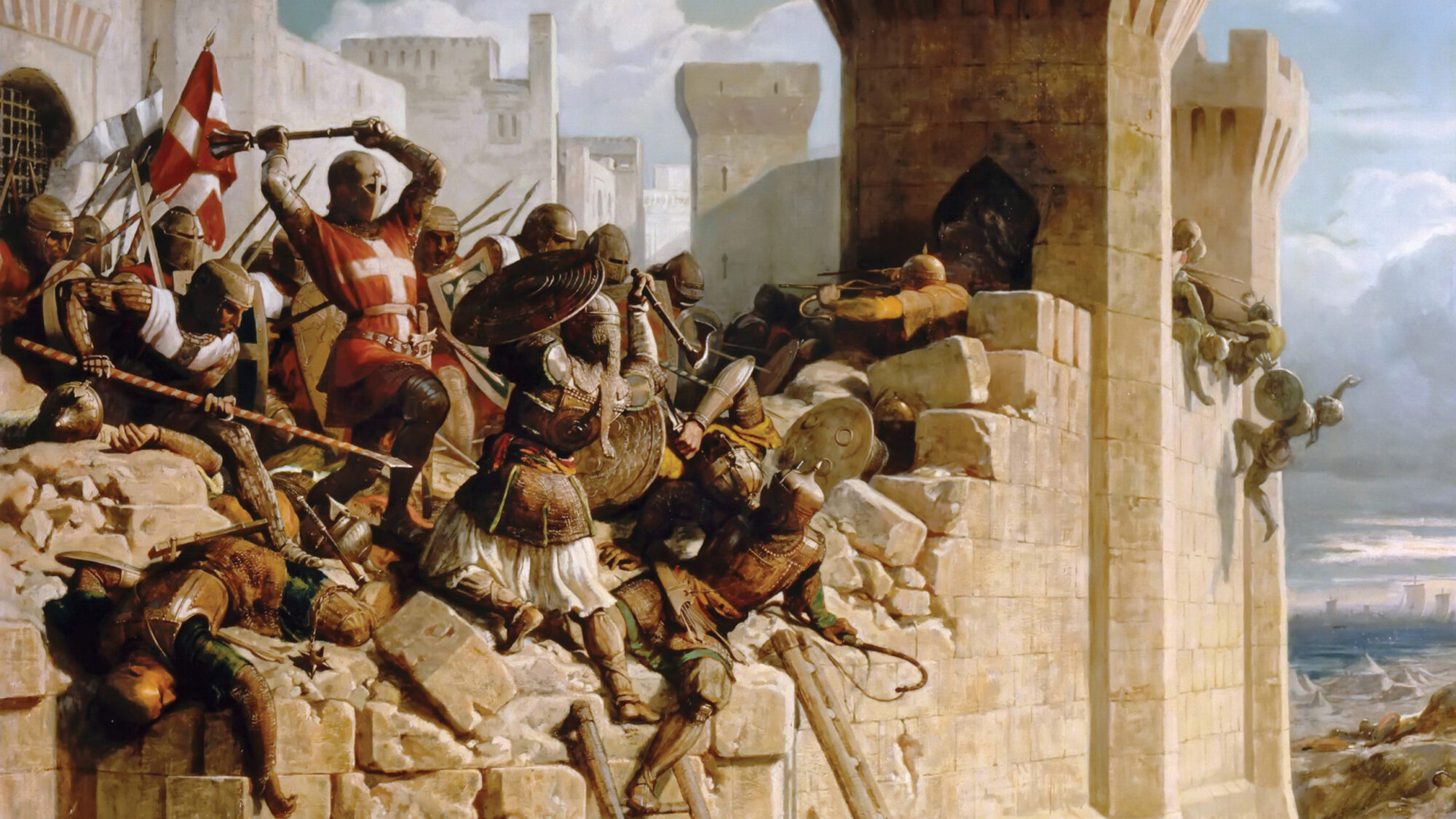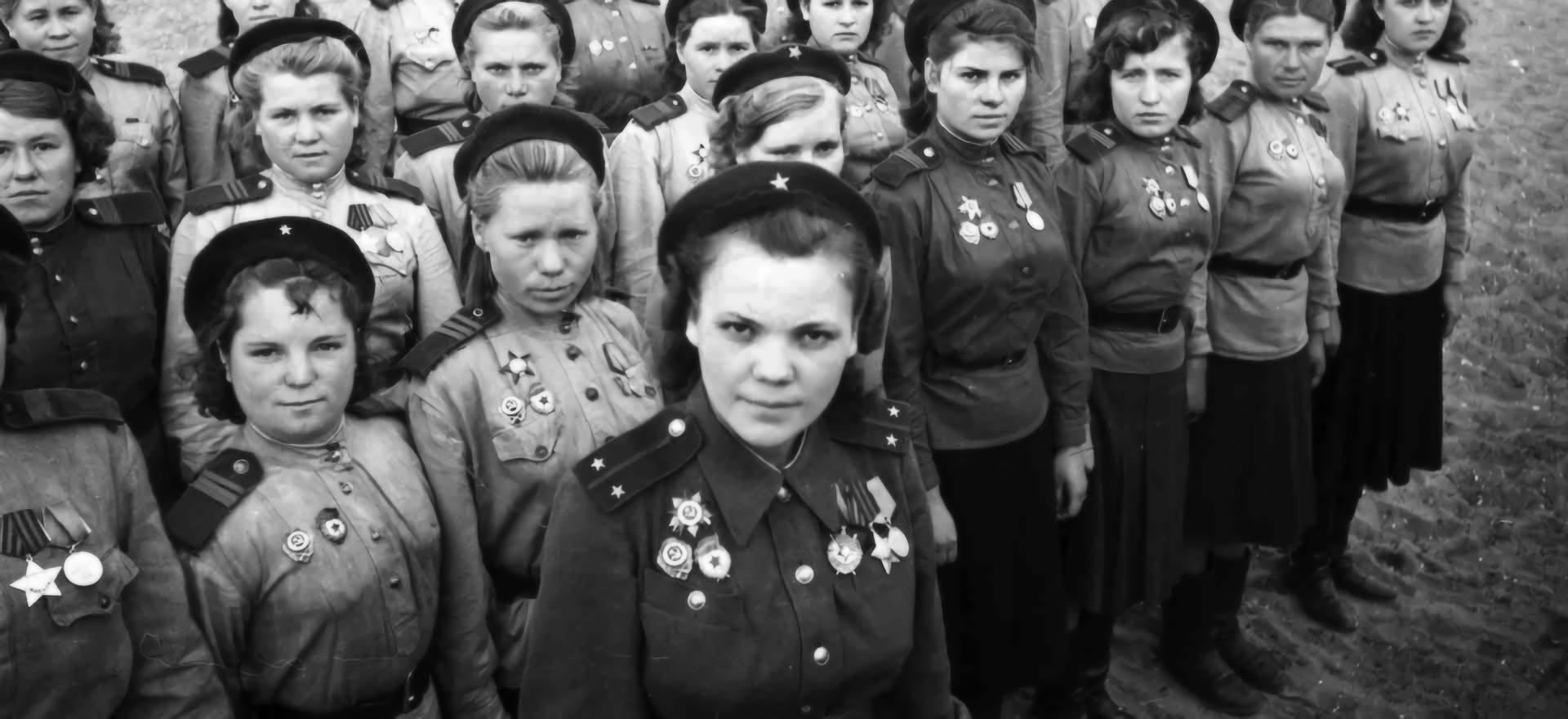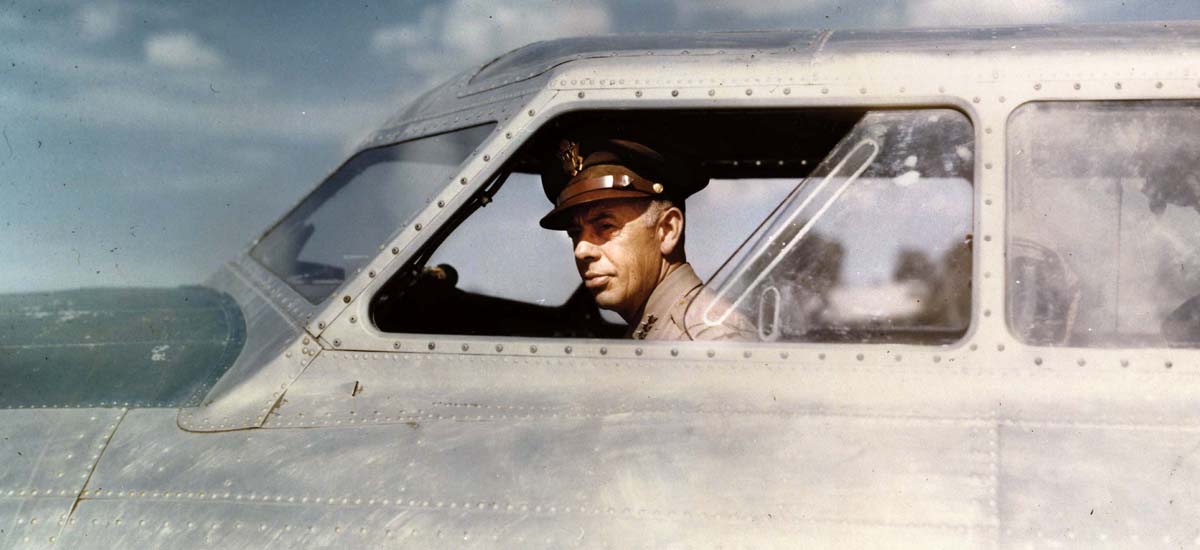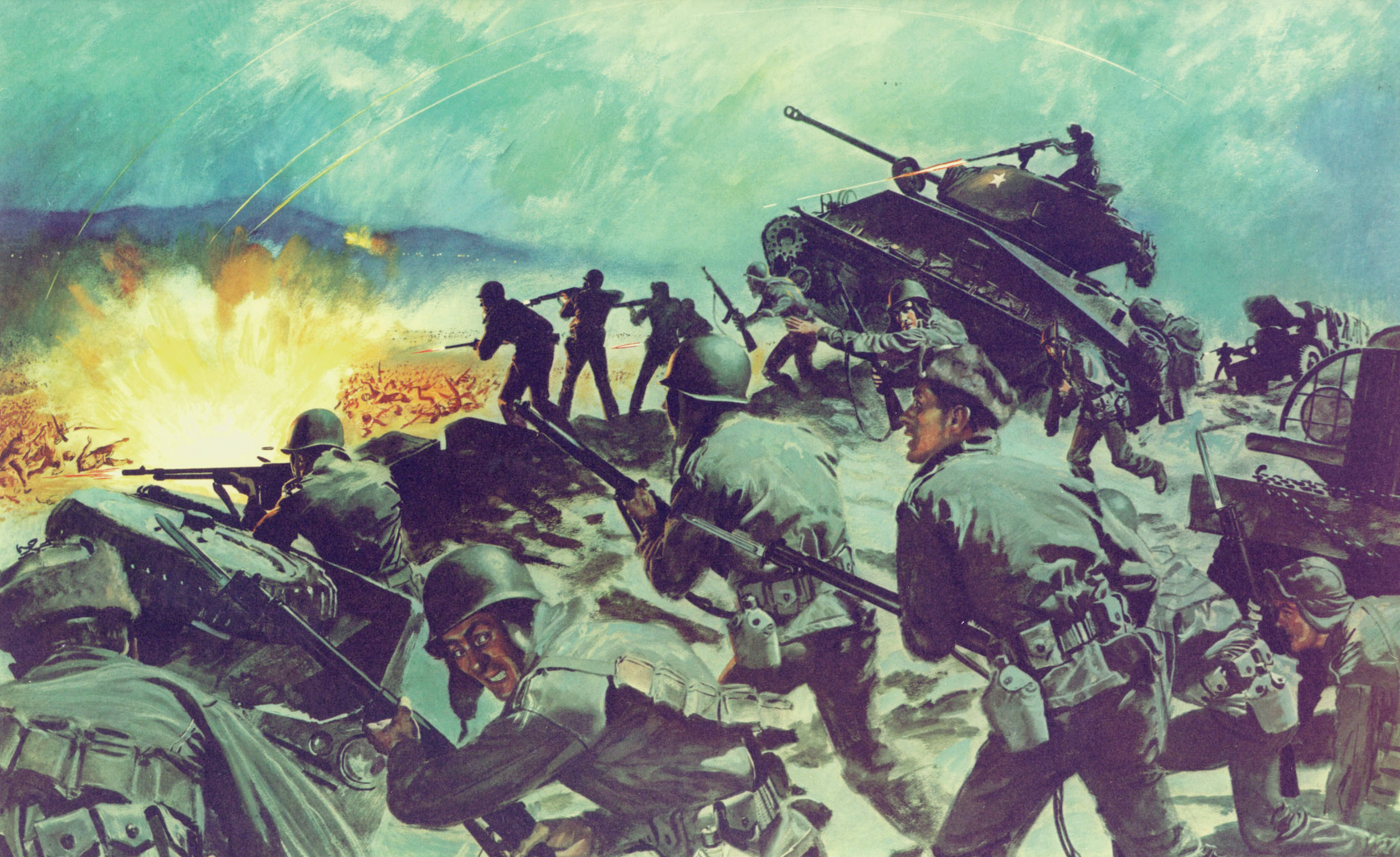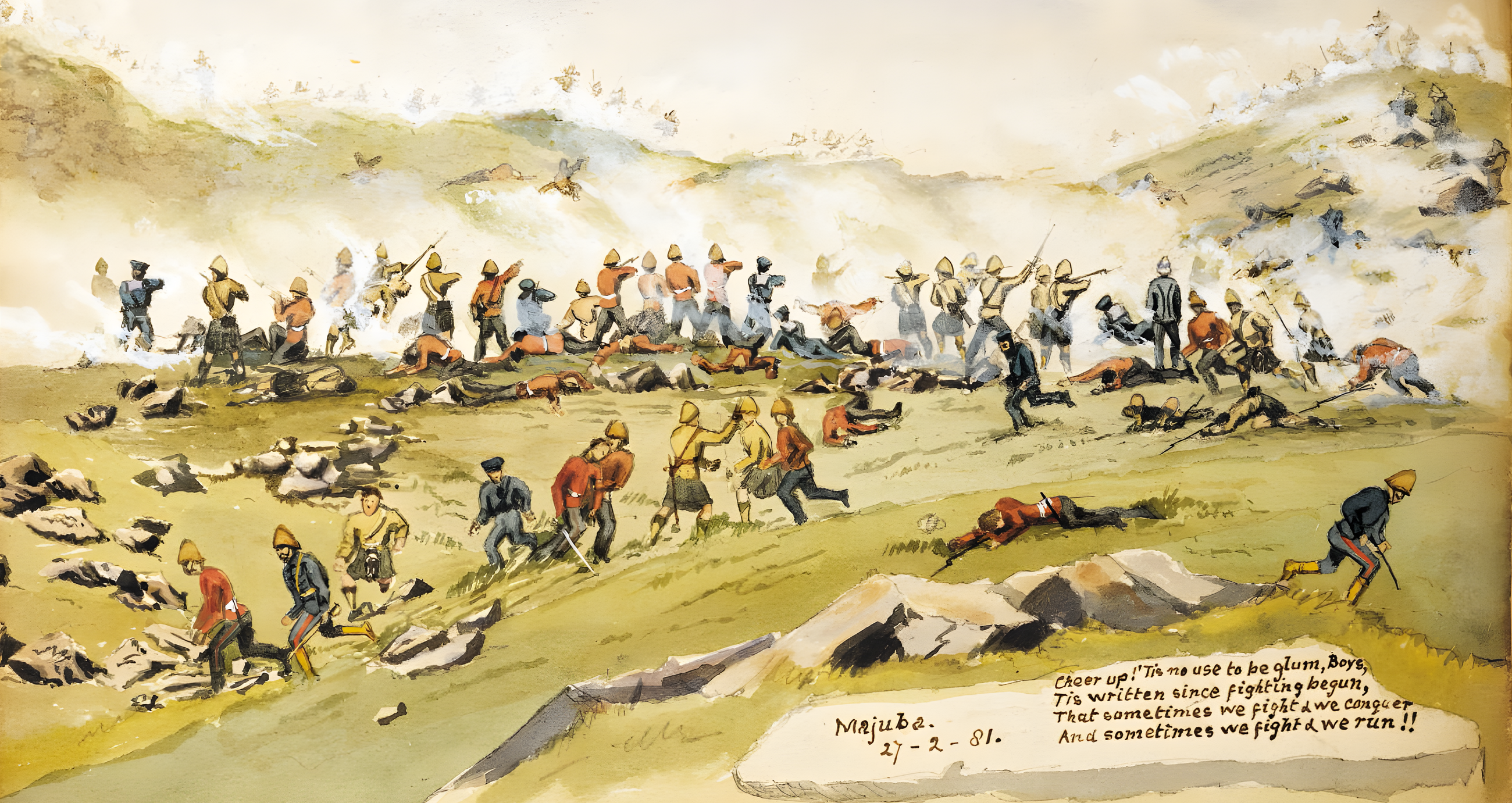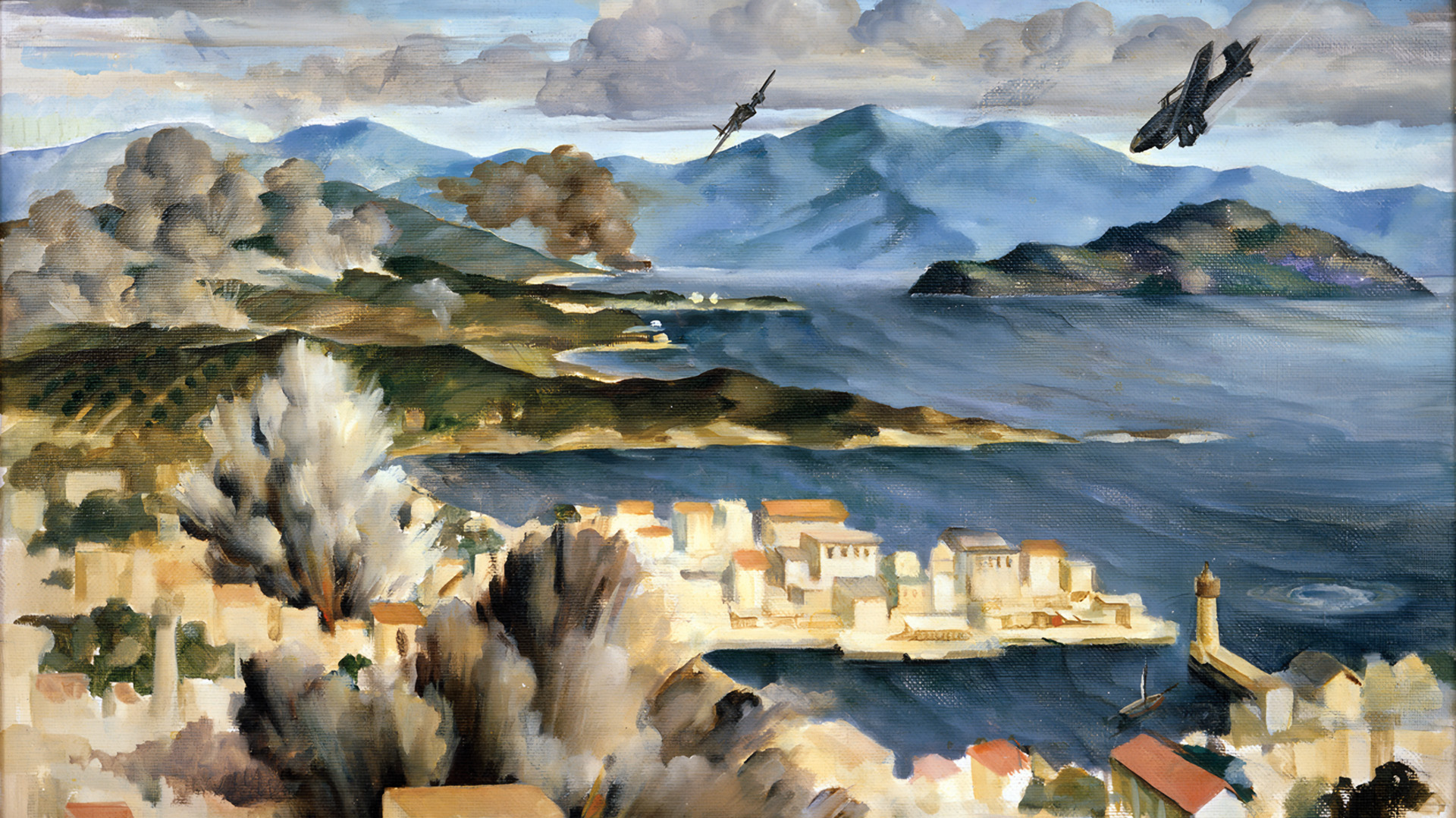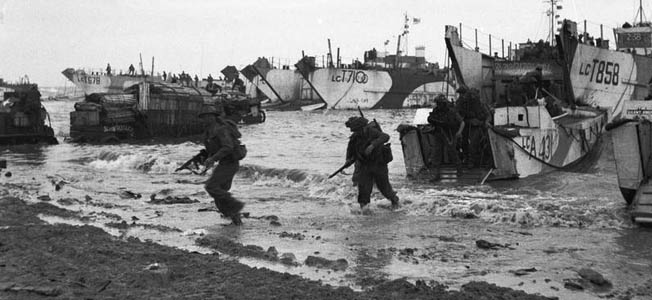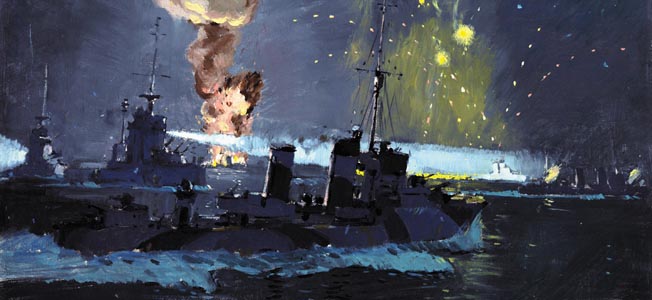By Christopher Miskimon
During the spring 1291 an enormous Muslim host moved against Acre along the Mediterranean coast. At the time it was Christendom’s last foothold in the Holy Land, a region fought over for centuries during
the religious wars known as the Crusades. The Muslim army aimed to finish the crusader presence once and for all.
It was the largest army Islam had ever assembled against the Crusaders. Its components were drawn from across the region. They came from Egypt, Syria, and Mesopotamia. Enslaved Turkish-speaking troops from across the Black Sea stood alongside emirs, mullahs, and dervishes. Many possessed a desire to wage holy war, but some served merely for the plunder.
As the army approached the city its power was evident. Camel-mounted musicians playing drums and horns rode beneath yellow banners, spurring forward cavalry with short bows in hand, their horses adorned in bright colors. Alongside came the infantry wearing armor made of mail or scaled leather with conical helmets atop their sweating brows. The foot soldiers carried a wide variety of weapons, including swords, spears, maces, javelins, and crossbows.
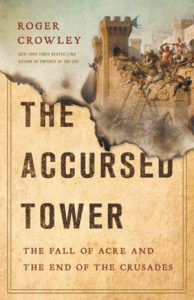 Worse yet for Acre were the carts and wagons, pulled by straining oxen and laden with lumber. This wood came from trees in the nearby Lebanese mountains, fashioned by craftsmen in Damascus into prefabricated components for the most fearsome artillery of the age. The Muslim army called them manjaniq, but the Europeans knew them as trebuchets. These large catapults were capable of hurling enormous stones against the walls of the city. All the pieces were in place for the final, bloody battle for the Holy Land.
Worse yet for Acre were the carts and wagons, pulled by straining oxen and laden with lumber. This wood came from trees in the nearby Lebanese mountains, fashioned by craftsmen in Damascus into prefabricated components for the most fearsome artillery of the age. The Muslim army called them manjaniq, but the Europeans knew them as trebuchets. These large catapults were capable of hurling enormous stones against the walls of the city. All the pieces were in place for the final, bloody battle for the Holy Land.
The siege of Acre was the Alamo of the Crusades. It began on April 4 and lasted six weeks. When the city fell to the Mameluke army on May 18, 1291, it marked the end of two centuries of conflict. Christians and Muslims struggled through those centuries for control of the region, in particular Jerusalem. With the fall of Acre, Christendom saw its hopes dashed. Calls for a renewed crusade continued until the 17th century, but for all intents and purposes, it was over. The story of this final great battle is told in blow-by-blow fashion in The Accursed Tower: The Fall of Acre and the End of the Crusades (Roger Crowley, Basic Books, New York, 2019, 272 pp., maps, photographs, notes, bibliography, index, $28.00, hardcover). The battle was significant in the larger history of both the Crusades and the medieval period.
This new history of the famous siege is told in vivid prose, with an engaging and diverse narrative. The author draws directly on all the existing Arabic sources along with untranslated Latin documents. He effectively explains the conflict within the context of the period, as the European crusaders were gradually pushed back by a determined Islamic jihad.
The author also demonstrates how the siege of Acre reveals advances in military planning and siege warfare, including mining techniques and the use of weapons such as the trebuchet. Descriptions of these technical methods are accompanied by accounts of both the personal heroism of the participants and the savagery they inflicted upon each other. Major personalities and the politics of the era are also given detailed attention. The book successfully provides a stirring account of the Latin Crusades’ bitter end at Acre.
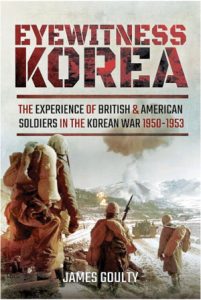 Eyewitness Korea: The Experience of British and American Soldiers in the Korean War 1950-1953 (James Goulty, Pen and Sword Books, South Yorkshire, UK, 2019, 240 pp., photographs, notes, bibliography, index, $39.95, hardcover)
Eyewitness Korea: The Experience of British and American Soldiers in the Korean War 1950-1953 (James Goulty, Pen and Sword Books, South Yorkshire, UK, 2019, 240 pp., photographs, notes, bibliography, index, $39.95, hardcover)
The Korean War was the first major conflict of the Cold War, but today it is often overshadowed by later actions. More than one million United Nations troops and many more Chinese and North Koreans fought in the conflict despite its relatively smaller scale. The combat they saw proved just as horrible and difficult as any other war and left its mark on the participants. Four million Koreans on both sides were killed, about 10 percent of the prewar population. When it ended in a tentative armistice in 1953, the country was smashed and ruined, requiring decades to rebuild and recover.
As an eyewitness history, this new work takes the reader to the battlefield level, revealing the experiences, thoughts, and viewpoints of soldiers on the front lines and elsewhere. The author takes their memoirs, letters, and diaries and mixes them with official histories and documents to provide a clear picture of what American and British soldiers went through. Also covered are men who were wounded in battle or captured and spent time in North Korean prisoner of war camps. It is an insightful book that captures the horror of the fighting, the bonds formed by the troops and the secrets of their morale and motivation.
 Women Heroes of the U.S. Army: Remarkable Soldiers from the American Revolution to Today (Ann McCallum Staats, Chicago Review Press, Chicago, IL, 2019, 240 pp., photographs, notes, bibliography, index, $19.99, softcover)
Women Heroes of the U.S. Army: Remarkable Soldiers from the American Revolution to Today (Ann McCallum Staats, Chicago Review Press, Chicago, IL, 2019, 240 pp., photographs, notes, bibliography, index, $19.99, softcover)
Margaret Corbin’s husband was an artilleryman in the Continental Army during the American Revolution. As she accompanied him during the army’s travels, she watched him and his fellow cannoneers practice using their field gun until she knew how to do it herself. On November 6, 1776, during the British attack on Fort Washington on the Hudson River, she watched her husband die, cut down alongside his cannon by a bullet. Margaret, employed bringing the men water up to that point, had no time to grieve. She stepped up to the gun she had spent hours observing and took over her husband’s duties. She fired round after round at the attacking British and Hessian troops until a blast of grapeshot struck her in the shoulder, chest, and jaw.
The fort surrendered and Corbin was taken prisoner, but later paroled. Afterward she took the nickname Captain Molly and was later awarded a soldier’s pension by the new American government. This made her the first woman to receive a military pension and, by extension, the first recognized female soldier of the United States Army. She would not be the last.
Captain Molly’s tale is one of 14 in this new work highlighting the service of women in the U.S. Army. The book is aimed at young adult readers and uses clear prose to convey the service of these women. It is well illustrated and contains extensive background information to place each woman’s story into the context of her time of service.
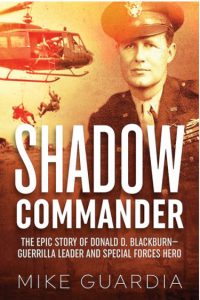 Shadow Commander: The Epic Story of Donald D. Blackburn—Guerrilla Leader and Special Forces Hero (Mike Guardia, Casemate Publishers, Havertown, PA, 2019, 240 pp., maps, photographs, bibliography, index, $19.95, softcover)
Shadow Commander: The Epic Story of Donald D. Blackburn—Guerrilla Leader and Special Forces Hero (Mike Guardia, Casemate Publishers, Havertown, PA, 2019, 240 pp., maps, photographs, bibliography, index, $19.95, softcover)
Donald Blackburn’s service to the United States spanned decades. It began in the Philippines in 1942. As U.S. forces were surrendering to the Imperial Japanese Army, he made his escape into the jungle-covered mountains of Northern Luzon. He raised a guerrilla army of 22,000 that fought the Japanese 14th Army and destroyed the naval base at Aparri. Blackburn stayed on active duty after World War II and spearheaded Special Forces operations in Laos in 1958. In Vietnam he initiated the cross-border reconnaissance missions into Cambodia and North Vietnam that discovered the Ho Chi Minh Trail. His operations against it caused great difficulties for the communist forces. He also was appointed to command of the famed Studies and Observations Group. Afterward, Blackburn led the design of the Son Tay prisoner of war rescue mission.
The subject of this biography is little known outside Special Forces circles, but he is an important figure in the development of American Special Forces. It is an award-winning book that received the Bronze Medal Book Award from the Military Writers Society of America. The author expertly reveals Blackburn’s maturation from a young, aggressive combat leader to a high-ranking commander who influenced an entire branch of the U.S. Army. The book is well researched and very readable.
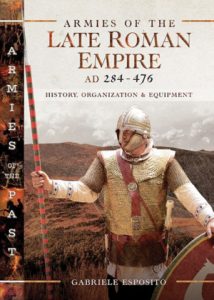 Armies of the Late Roman Empire ad 284 to 476: History, Organization and Equipment (Gabrielle Esposito, Pen and Sword Military, South Yorkshire, UK, 2019, 208 pp., maps, photographs, appendices, bibliography, index, $34.95, hardcover)
Armies of the Late Roman Empire ad 284 to 476: History, Organization and Equipment (Gabrielle Esposito, Pen and Sword Military, South Yorkshire, UK, 2019, 208 pp., maps, photographs, appendices, bibliography, index, $34.95, hardcover)
Rome was a great power for centuries, undergoing gradual but definitive changes in its military due to technological progress, political developments, and the reality of decline. The period from ad 284 to 476 saw dramatic changes as the Western Empire slowly declined and then ended. While the Roman Army remained formidable, reliable, and efficient almost until the very end, it struggled to adapt to the changing circumstance of the nation. There were more types of troops in service, including field armies, frontier units, allied troops, and mercenaries and different groups of bodyguards. Together these disparate units defended Rome until it was no more.
This new volume is one in a series on the Roman military, with this book covering the end in the West. The author discusses the origins and causes of the military fall and provides extensive details on weapons, equipment, tactics, organization, and combat history.
The book is extensively illustrated, mostly in full color with many photographs using Roman Army reenactors to illustrate what the troops looked like based on available evidence. There is also a detailed study of Roman shield designs exhibiting the wide variety of symbols and decorations used by the troops to distinguish themselves on a battlefield. This book’s information is largely drawn from the Notitia Dignitatum, a vital surviving source.
 Life in Jefferson Davis’ Navy (Barbara Brooks Tomblin, Naval Institute Press, Anna-polis, MD, 2019, 336 pp., maps, photographs, notes, bibliography, index, $54.00, hardcover)
Life in Jefferson Davis’ Navy (Barbara Brooks Tomblin, Naval Institute Press, Anna-polis, MD, 2019, 336 pp., maps, photographs, notes, bibliography, index, $54.00, hardcover)
On July 1, 1862, two Union naval forces combined on the Mississippi River just above Vicksburg. This compelled the Confederate officer commanding the city’s defenses, Maj. Gen. Earl Van Dorn, to reassess his plans. He ordered the fast completion of the nearby CSS Arkansas, an ironclad ram also armed with eight guns of various types.
Despite the long odds, he felt it was better to die in action. On July 15, Arkansas went into action, first encountering the Union warships Carondelet, Tyler, and Queen of the West. A chase ensued with Arkansas attempting to ram Carondelet, instead forcing her aground and continuing toward the main Union fleet. There Arkansas ran a gauntlet of shot and shell, receiving horrible damage but sailing through the entire Union force to shelter at Vicksburg. It was a boost to the city’s morale and an embarrassment to the Union Navy. One commentary noted the feat was more impressive than that of the CSS Virginia at Hampton Roads.
The naval actions of the American Civil War are often overlooked in favor of the land campaigns, but sailors fought just as hard and made similar sacrifices. This new work concentrates on the experiences of Confederate sailors, who fought with distinct disadvantages in numbers and firepower, but nonetheless carved out a legacy of courage and endurance second to none. The author uses diaries, letters, and newspaper accounts to flesh out the narrative, resulting in lively storytelling that accurately relays the sailors’ accomplishments and experiences.
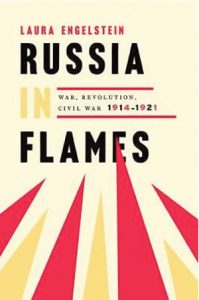 Russia in Flames: War, Revolution, Civil War 1914-1921 (Laura Engelstein, Oxford University Press, Oxford, UK, 2019, 823 pp., maps, photographs, notes, bibliography, index, $24.95, softcover)
Russia in Flames: War, Revolution, Civil War 1914-1921 (Laura Engelstein, Oxford University Press, Oxford, UK, 2019, 823 pp., maps, photographs, notes, bibliography, index, $24.95, softcover)
By 1913 the Romanov dynasty had ruled Russia for three centuries. A year later Russia went to war with Germany and Austria-Hungary as World War I spread through Europe and beyond. By February 1917 the Romanovs were no longer in power, their long rule ended. The war was a disaster Czar Nicholas II was unable to control and Russian society rose up against the regime.
In October 1917 the Bolsheviks engaged their coup against the fledgling government, starting four years of civil war. The conflict is estimated to have killed nine percent of the Russian population, the bulk of those losses due to starvation and famine. Foreign powers tried to bolster the White forces opposing the Bolsheviks, who quickly became known as the Reds. After a bitter struggle the communists emerged victorious, beginning the seven-decade rule of the Soviet Union.
The Russian Revolution was a critical event in world history that defined the 20th century and has lingering effects today. The author covers the monumental events of the period in extensive detail using clear prose. The scope of this work is as broad as the Russian steppes and as deep as the torrents of bloodshed to cause the death of one empire and the rise of a new one.
 Short Bursts
Short Bursts
Vietnam Bao Chi: Warriors of Word and Film (Marc Phillip Yablonka, Casemate Publishing, 2018, $32.95, hardcover) This is the first book to focus on the experiences of military combat cameramen and correspondents in Vietnam. It includes the accounts of dozens of different service members.
Malayan Emergency: Triumph of the Running Dogs 1948-1960 (Gerry Van Tonder, Pen and Sword Books, 2019, $22.95, softcover) This was one of the first insurgencies of the Cold War and one of a handful to be successfully defeated. A wide range of forces and techniques were used to defeat it.
For God and Glory: Lord Nelson and His Way of War (Joel Hayward, Naval Institute Press, 2019, $24.95, softcover) Nelson was a naval genius who spread his ethos throughout the British Royal Navy. This book assesses how he made that possible.
Brotherhood of Spies: The U-2 and the CIA’s Secret War (Monte Reel, Anchor Books, 2019, $17.00, softcover) The U-2 spy plane program was a technological success that mixed clandestine achievements with a very public failure. It was instrumental in intelligence gathering during the Cold War.
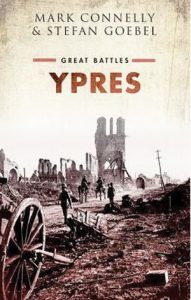 Great Battles: Ypres (Mark Connelly and Stefan Goebel, Oxford University Press, 2019, $27.95, hardcover) Ypres was the site of several battles during World War I. This detailed and informative book summarizes the town’s place in the conflict.
Great Battles: Ypres (Mark Connelly and Stefan Goebel, Oxford University Press, 2019, $27.95, hardcover) Ypres was the site of several battles during World War I. This detailed and informative book summarizes the town’s place in the conflict.
Fighting for Atlanta: Tactics, Terrain and Trenches in the Civil War (Earl J. Hess, University of North Carolina Press, 2019, $45.00, hardcover) Fortifications were a major factor in the fighting for Atlanta in 1864. The author examines how they influenced the campaign and how commanders adapted to them.
Sacred Duty: A Soldier’s Tour at Arlington National Cemetery (Tom Cotton, William Morrow, 2019, $28.99, hardcover) The author is a U.S. Senator who served in Iraq and Afghanistan. This is his story of the famed 3rd Infantry Regiment, in which he served for 16 months.
The Khazars: A Judeo-Turkish Empire on the Steppes, 7th-11th Centuries AD (Mikhail Zhirohov and David Nicholle, Osprey Publishing, 2019, $19.00, softcover) The Khazars were expert in the use of armor and the tactics of the horse-army. Over the centuries their armies fought Russians, Byzantines, and the Muslim Caliphates.
